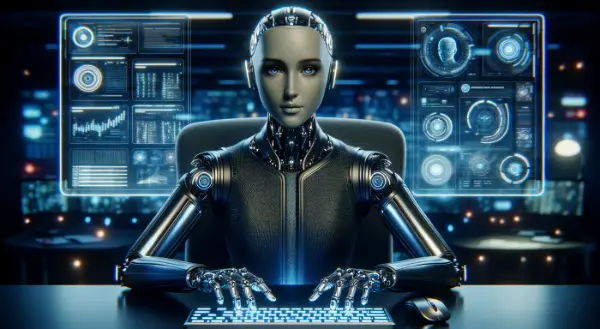1. Complexity of Human Creativity and Problem-Solving
One of the most significant reasons AI won’t replace web developers anytime soon is the complexity of human creativity and problem-solving. Web development is not just about writing code or following templates; it’s about creating unique, tailored solutions that meet specific client needs. Human developers bring a level of creativity and innovative thinking that current AI technologies cannot match.
Web developers often need to devise solutions for novel problems, adapt designs to fit unique client requirements, and navigate complex user experiences. While AI can handle repetitive tasks and generate code based on existing patterns, it struggles with tasks that require genuine innovation and a deep understanding of user needs. The human ability to think outside the box and adapt to new situations remains a crucial aspect of web development that AI is far from mastering.
2. Complex and Evolving Requirements
Web development projects often come with complex and evolving requirements. Clients may change their needs or expectations partway through a project, requiring developers to adapt quickly. AI systems, while capable of following pre-set rules and patterns, may not handle such dynamic and evolving scenarios with the same agility as human developers.
Developers also need to understand and interpret the nuanced needs of clients, something that involves more than just processing information. Human interaction, empathy, and communication are critical in ensuring that the final product aligns with the client’s vision and objectives. AI systems lack the capacity for such nuanced understanding and flexible adaptation.
3. Human-Centric Design and User Experience
Creating a website that is not only functional but also user-friendly involves a deep understanding of human behavior and psychology. Web developers often need to consider various factors like usability, accessibility, and aesthetics to ensure that the site delivers a positive user experience.
AI can analyze data and make recommendations based on patterns, but it cannot fully grasp the subtleties of human interaction. For instance, designing an interface that is intuitive for diverse user groups requires insights into human behavior that go beyond statistical analysis. The ability to empathize with users and anticipate their needs is a uniquely human skill that current AI technologies struggle to replicate.
4. Ethical and Moral Considerations
The ethical and moral implications of web development are another area where AI falls short. Developers often need to make decisions that align with ethical guidelines and consider the broader impact of their work on society. This includes issues like data privacy, accessibility, and inclusivity.
AI systems operate based on algorithms and data inputs, and while they can be programmed to follow certain ethical guidelines, they lack the ability to understand and navigate complex ethical dilemmas in the way humans can. Human developers are essential in ensuring that web development practices adhere to ethical standards and consider the societal implications of their work.
5. Collaboration and Communication Skills
Web development is rarely a solitary activity. It often involves collaboration with designers, content creators, marketers, and other stakeholders. Effective communication and teamwork are crucial for the success of a project. Developers need to articulate technical concepts to non-technical team members, negotiate solutions, and work harmoniously with others to achieve the project goals.
AI lacks the interpersonal skills required for effective collaboration. While AI tools can assist with certain aspects of communication, they cannot replace the nuanced and dynamic interactions that occur between human team members. The ability to work as part of a team and navigate complex interpersonal dynamics is a significant factor that keeps human developers at the forefront of the industry.
6. Customization and Personalization
Every client has unique needs, and web development often involves creating highly customized solutions. AI-generated templates and code might work for generic applications, but they fall short when it comes to tailoring solutions for specific requirements.
Human developers excel in creating personalized and bespoke solutions that align perfectly with the client’s vision and objectives. They can understand the context of the project, integrate client feedback, and make adjustments that reflect the individual needs of each client. This level of customization is challenging for AI to achieve, as it often requires a deep understanding of the client’s business, brand, and goals.
7. Adaptability to New Technologies
The web development landscape is constantly evolving with new technologies, frameworks, and standards emerging regularly. Developers need to stay updated with the latest trends and be adaptable to incorporate new tools and methodologies into their work.
While AI can be trained to work with existing technologies, its ability to adapt to rapid changes in the technological landscape is limited. Human developers are better equipped to learn and integrate new technologies, ensuring that they can continue to provide relevant and up-to-date solutions.
8. Maintenance and Debugging
Maintaining and debugging web applications is an ongoing process that requires a deep understanding of the codebase and the ability to diagnose and fix issues that arise. While AI tools can assist with some aspects of debugging, they cannot fully replace the expertise of a human developer in understanding the intricacies of the code and the system as a whole.
Human developers possess the problem-solving skills and contextual knowledge needed to troubleshoot complex issues and ensure that web applications continue to function smoothly. The ability to adapt and respond to unforeseen challenges is a crucial aspect of web development that AI is not yet capable of handling independently.
9. Client Relationships and Trust
Building and maintaining client relationships is a vital part of web development. Clients often seek developers who can not only deliver a high-quality product but also provide personalized service, understand their needs, and build trust.
AI lacks the ability to foster relationships and build trust with clients. The human touch in client interactions, including empathy, understanding, and personalized communication, plays a significant role in ensuring client satisfaction and loyalty. This aspect of web development is something that AI cannot replicate.
10. The Human Element in Creativity
Finally, the human element in creativity is a significant factor in web development. Creative design, user experience, and innovative solutions are often driven by human intuition, experience, and imagination. While AI can generate designs based on existing patterns, it lacks the ability to truly innovate and push the boundaries of creativity.
Human developers bring a unique perspective and creativity to their work that AI tools cannot replicate. The ability to think creatively, experiment with new ideas, and explore unconventional solutions is an essential part of web development that ensures the industry continues to evolve and innovate.
In conclusion while AI has undoubtedly made significant advancements in various fields, including web development, there are numerous reasons why it is unlikely to replace web developers anytime soon. The complexity of human creativity, the need for personalized solutions, the importance of client relationships, and the ability to adapt to new technologies all underscore the continued relevance of human developers in the industry.
AI tools can certainly assist with certain tasks and enhance the efficiency of web development processes, but they are not yet capable of fully replacing the expertise, creativity, and interpersonal skills that human developers bring to the table. As technology continues to evolve, it is likely that AI will become an increasingly valuable tool for web developers, but the unique contributions of human developers will remain essential for the foreseeable future.








